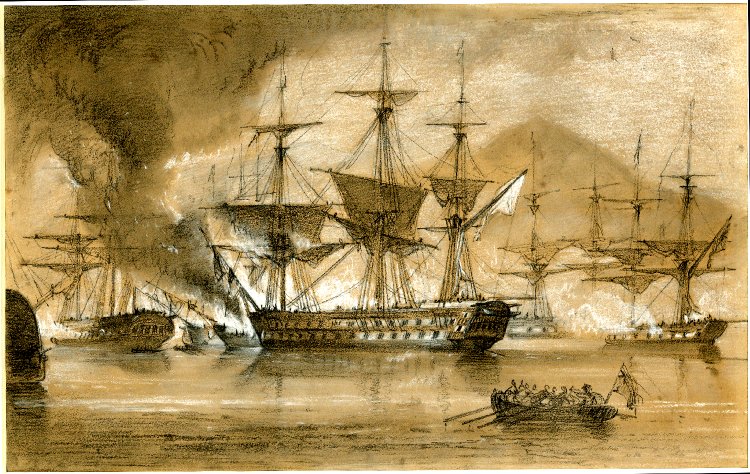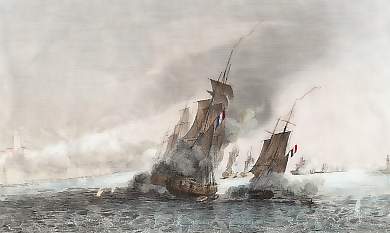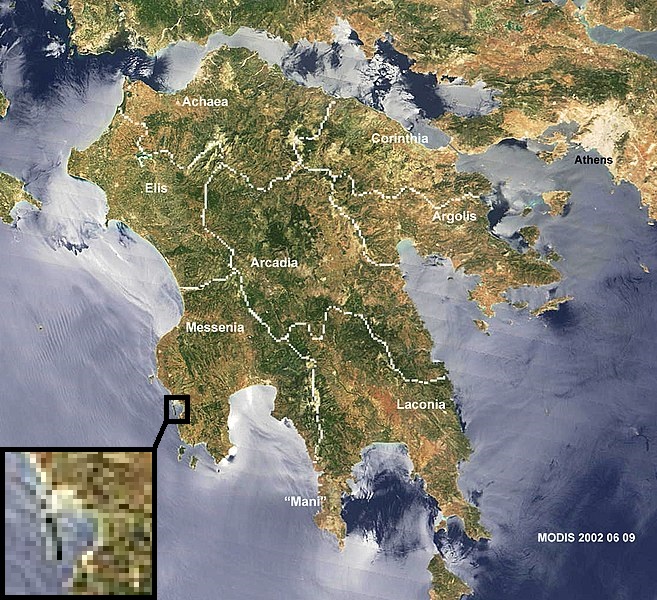|
French Ship Trident (1811)
The ''Trident'' was a 74-gun ship of the line of the French Navy. On 13 February 1814, she was part of Julien Cosmao's squadron which was intercepted off Toulon by a British blockade. The , at the rear, managed to hold off the British ships long enough for the rest of the squadron to escape. In 1823, during the Spanish expedition, she took part in the bombardment of Cadiz, along with . In 1827, at the Battle of Navarino, she silenced coastal defences with the ''Sirène''. She took part in the Invasion of Algiers in 1830. In 1831, the served as flagship of the Toulon squadron under Rear-admiral Baron Hugon, and took part in the Battle of the Tagus under Captain Casy, reaching Lisbon. In 1854, she took part in the Crimean War, and was used as a troop ship the next year in the Black Sea. She was struck on 24 November 1857 and was used as a barracks hulk The Hulk is a superhero appearing in American comic books published by Marvel Comics. Created by writer Stan Lee and ar ... [...More Info...] [...Related Items...] OR: [Wikipedia] [Google] [Baidu] |
George Philip Reinagle
George Philip Reinagle (1802 – 6 December 1835) was an English marine painter, Life George Philip Reinagle was born in 1802 and was the third son of painter Ramsay Richard Reinagle. He began painting under the tutelage of his father, though would mostly develop his skills by studying the works of Ludolf Backhuysen and Willem van de Velde. Reinagle would paint with oil as well as watercolours. In 1822, he presented his work for the first time at the Royal Academy, showing a portrait of a gentleman. He would then exhibit ''Ship in a Storm firing a Signal of Distress'' and a ''Calm'' in 1824, and ''A Dutch Fleet of the Seventeenth Century coming to Anchor in a Breeze'' the following year. In 1827, he witnessed the battle of Navarino and would subsequently paint a number of paintings depicting the battle such as ''Illustrations of the Battle of Navarin'' and ''Illustrations of the Occurrences at the Entrance of the Bay of Patras between the English Squadron and Turkish Fleets 18 ... [...More Info...] [...Related Items...] OR: [Wikipedia] [Google] [Baidu] |
Julien Cosmao
Julien Marie Cosmao-Kerjulien (Châteaulin, Finistère, 27 November 1761 – Brest, 17 February 1825) was a French Navy officer, admiral, best remembered for his role in the Battle of Trafalgar. Career Early career Completing his studies in Châteaulin, young Cosmao-Kerjulien joined the French Royal Navy in 1776, against his parents' will. He served in the ''Aigrette'' in the Caraibs. Back to Brest in 1778, he served on the ''Oiseau'' with Corentin de Leissegues. In September, after the beginning of the American Revolutionary War, he served on the ''Nymphe'', taking part in two battles against English privateers, near Bordeaux and Belle-Isle. Between January 1779 and April 1781, he served in Guyana aboard the brig ''Hirondelle'', fighting two more English privateers and capturing two East Indiamen. He was promoted to Lieutenant of an auxiliary frigate in September 1781. He served successively aboard the ''Pégase'' (February 1782) and the ''Protecteur'' (March) befor ... [...More Info...] [...Related Items...] OR: [Wikipedia] [Google] [Baidu] |
Ships Of The Line Of The French Navy
A ship is a large watercraft that travels the world's oceans and other sufficiently deep waterways, carrying cargo or passengers, or in support of specialized missions, such as defense, research, and fishing. Ships are generally distinguished from boats, based on size, shape, load capacity, and purpose. Ships have supported exploration, trade, warfare, migration, colonization, and science. After the 15th century, new crops that had come from and to the Americas via the European seafarers significantly contributed to world population growth. Ship transport is responsible for the largest portion of world commerce. The word ''ship'' has meant, depending on the era and the context, either just a large vessel or specifically a ship-rigged sailing ship with three or more masts, each of which is square-rigged. As of 2016, there were more than 49,000 merchant ships, totaling almost 1.8 billion dead weight tons. Of these 28% were oil tankers, 43% were bulk carriers, and 13% were co ... [...More Info...] [...Related Items...] OR: [Wikipedia] [Google] [Baidu] |
Hulk (ship)
A hulk is a ship that is afloat, but incapable of going to sea. Hulk may be used to describe a ship that has been launched but not completed, an abandoned wreck or shell, or to refer to an old ship that has had its rigging or internal equipment removed, retaining only its buoyant qualities. The word hulk also may be used as a verb: a ship is "hulked" to convert it to a hulk. The verb was also applied to crews of Royal Navy ships in dock, who were sent to the receiving ship for accommodation, or "hulked". Hulks have a variety of uses such as housing, prisons, salvage pontoons, gambling sites, naval training, or cargo storage. In the days of sail, many hulls served longer as hulks than they did as functional ships. Wooden ships were often hulked when the hull structure became too old and weak to withstand the stresses of sailing. More recently, ships have been hulked when they become obsolete or when they become uneconomical to operate. Sheer hulk A sheer hulk (or shear hulk) w ... [...More Info...] [...Related Items...] OR: [Wikipedia] [Google] [Baidu] |
Crimean War
The Crimean War, , was fought from October 1853 to February 1856 between Russia and an ultimately victorious alliance of the Ottoman Empire, France, the United Kingdom and Piedmont-Sardinia. Geopolitical causes of the war included the decline of the Ottoman Empire, the expansion of the Russian Empire in the preceding Russo-Turkish Wars, and the British and French preference to preserve the Ottoman Empire to maintain the balance of power in the Concert of Europe. The flashpoint was a disagreement over the rights of Christian minorities in Palestine, then part of the Ottoman Empire, with the French promoting the rights of Roman Catholics, and Russia promoting those of the Eastern Orthodox Church. The churches worked out their differences with the Ottomans and came to an agreement, but both the French Emperor Napoleon III and the Russian Tsar Nicholas I refused to back down. Nicholas issued an ultimatum that demanded the Orthodox subjects of the Ottoman Empire be placed ... [...More Info...] [...Related Items...] OR: [Wikipedia] [Google] [Baidu] |
Lisbon
Lisbon (; pt, Lisboa ) is the capital and largest city of Portugal, with an estimated population of 544,851 within its administrative limits in an area of 100.05 km2. Grande Lisboa, Lisbon's urban area extends beyond the city's administrative limits with a population of around 2.7 million people, being the List of urban areas of the European Union, 11th-most populous urban area in the European Union.Demographia: World Urban Areas - demographia.com, 06.2021 About 3 million people live in the Lisbon metropolitan area, making it the third largest metropolitan area in the Iberian Peninsula, after Madrid and Barcelona. It represents approximately 27% of the country's population. [...More Info...] [...Related Items...] OR: [Wikipedia] [Google] [Baidu] |
Battle Of The Tagus
The Battle of the Tagus was a naval engagement that took place on 11 July 1831 at the mouth of the Tagus river, in Portugal. A French fleet attacked and subdued Portuguese fortifications at the entrance of the Tagus, with the aim to strong-arm the government of Miguel I into recognising the newly established Kingdom of the French. The damage to the forts defending access to the Tagus and the arrival of French warships at Lisbon forced the Portuguese to cave in and comply with French demands. Background The accession of King Miguel I to the throne of Portugal and abolition of the Constitutional Charter had put the country under the rule of an absolutist monarch. Liberals challenged his rule, and the struggle of the Liberal Wars ensued. The government of Miguel I was hostile to France, and became even more so when the popular insurrection of the July Revolution deposed the absolutist Bourbon king Charles X, and established a constitutional monarchy in which Louis-Philippe had ... [...More Info...] [...Related Items...] OR: [Wikipedia] [Google] [Baidu] |
Invasion Of Algiers In 1830
The invasion of Algiers in 1830 was a large-scale military operation by which the Kingdom of France, ruled by Charles X, invaded and conquered the Deylik of Algiers. Algiers was annexed by the Ottoman Empire in 1529 after the capture of Algiers in 1529 and had been under direct rule until 1710, when Baba Ali Chaouch achieved de facto independence from the Ottomans, though the Regency was still nominally a part of the Ottoman Empire. The Deylik of Algiers elected its rulers through a parliament called the Divan of Algiers. These rulers/kings were known as Deys. The state could be best described as an Elective monarchy. A diplomatic incident in 1827, the so-called Fan Affair (Fly Whisk Incident), served as a pretext to initiate a blockade against the port of Algiers. After three years of standstill and a more severe incident in which a French ship carrying an ambassador to the dey with a proposal for negotiations was bombarded, the French determined that more forceful action ... [...More Info...] [...Related Items...] OR: [Wikipedia] [Google] [Baidu] |
Battle Of Navarino
The Battle of Navarino was a naval battle fought on 20 October (O. S. 8 October) 1827, during the Greek War of Independence (1821–29), in Navarino Bay (modern Pylos), on the west coast of the Peloponnese peninsula, in the Ionian Sea. Allied forces from Britain, France, and Russia decisively defeated Ottoman and Egyptian forces which were trying to suppress the Greeks, thereby making Greek independence much more likely. An Ottoman armada which, in addition to Imperial warships, included squadrons from the ''eyalets'' (provinces) of Egypt and Tunis, was destroyed by an Allied force of British, French and Russian warships. It was the last major naval battle in history to be fought entirely with sailing ships, although most ships fought at anchor. The Allies' victory was achieved through superior firepower and gunnery. The context of the three Great Powers' intervention in the Greek conflict was the Russian Empire's long-running expansion at the expense of the decaying Ottoman ... [...More Info...] [...Related Items...] OR: [Wikipedia] [Google] [Baidu] |
Hundred Thousand Sons Of Saint Louis
"The Hundred Thousand Sons of Saint Louis" was the popular name for a French army mobilized in 1823 by the Bourbon King of France, Louis XVIII, to help the Spanish Royalists restore King Ferdinand VII of Spain to the absolute power of which he had been deprived during the Liberal Triennium. Despite the name, the actual number of troops was around 60,000. The force comprised some five army corps (the bulk of the French regular army) and was led by the Duke of Angoulême, the son of the future King Charles X of France. The French name of the conflict is ''l'Expédition d'Espagne'' ("the Expedition of Spain"). Context In 1822, Ferdinand VII applied the terms of the Congress of Vienna, lobbied for the assistance of the other absolute monarchs of Europe, in the process joining the Holy Alliance formed by Russia, Prussia, Austria and France to restore absolutism. In France, the ultra-royalists pressured Louis XVIII to intervene. To temper their counter-revolutionary ardor, the Duc d ... [...More Info...] [...Related Items...] OR: [Wikipedia] [Google] [Baidu] |
Toulon
Toulon (, , ; oc, label= Provençal, Tolon , , ) is a city on the French Riviera and a large port on the Mediterranean coast, with a major naval base. Located in the Provence-Alpes-Côte d'Azur region, and the Provence province, Toulon is the prefecture of the Var department. The Commune of Toulon has a population of 176,198 people (2018), making it France's 13th-largest city. It is the centre of an urban unit with 580,281 inhabitants (2018), the ninth largest in France. Toulon is the third-largest French city on the Mediterranean coast after Marseille and Nice. Toulon is an important centre for naval construction, fishing, wine making, and the manufacture of aeronautical equipment, armaments, maps, paper, tobacco, printing, shoes, and electronic equipment. The military port of Toulon is the major naval centre on France's Mediterranean coast, home of the French aircraft carrier ''Charles de Gaulle'' and her battle group. The French Mediterranean Fleet is based in Toulon. ... [...More Info...] [...Related Items...] OR: [Wikipedia] [Google] [Baidu] |







